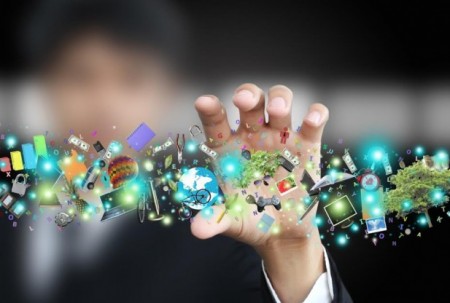April 20, 2015 – Peter Diamandis, author of “Bold” and “Abundance” sends out a weekly email in which he describes a technology and its potential impact. This came to my desk yesterday and I had to share it with my readers. It is about the Internet of Everything or IoE.
First of all, what is it? IoE is the superset of the Internet of Things. It describes networked connections between devices, people, processes and data. By 2020, it may connect 50 billion devices and things to people. Cisco, the telecommunications company, describes the IoE as a $19 trillion business just in the next decade alone – $14 trillion coming from the private sector, and $5 trillion from government, and initiatives like smart cities and infrastructure.
The remaining words come from the mouth of the man in the picture above.
Imagine a Connected World
Let me try to paint an IoE picture for you.
Imagine a world in which everything is connected and packed with sensors.
50+ billion connected devices, loaded with a dozen or more sensors, will create a trillion-sensor ecosystem.
These devices will create what I call a state of perfect knowledge, where we’ll be able to know what we want, where we want, when we want.
Combined with the power of data mining and machine learning, the value that you can create and the capabilities you will have as an individual and as a business will be extraordinary.
Here are a few basic examples to get you thinking:
Retail: Beyond knowing what you purchased, stores will monitor your eye gaze, knowing what you glanced at… what you picked up and considered, and put back on the shelf. Dynamic pricing will entice you to pick it up again.
City Traffic: Cars looking for parking cause 40% of traffic in city centers. Parking sensors will tell your car where to find an open spot.
Lighting: Streetlights and house lights will only turn on when you’re nearby.
Vineyards/Farming: Today IoE enables winemakers to monitor the exact condition (temperature, humidity, sun) of every vine and recommend optimal harvest times. IoE can follow details of fermentation and even assure perfect handling through distribution and sale to the consumer at the wine store.
Dynamic pricing: In the future, everything has dynamic pricing where supply and demand drives pricing. Uber already knows when demand is high, or when I’m stuck miles from my house, and can charge more as a result.
Transportation: Self-driving cars and IoE will make ALL traffic a thing of the past.
Healthcare: You will be the CEO of your own health. Wearables will be tracking your vitals constantly, allowing you and others to make better health decisions.
Banking/Insurance: Research shows that if you exercise and eat healthy, you’re more likely to repay your loan. Imagine a variable interest rate (or lower insurance rate) depending on exercise patterns and eating habits?
Forests: With connected sensors placed on trees, you can make urban forests healthier and better able to withstand — and even take advantage of — the effects of climate change.
Office Furniture: Software and sensors embedded in office furniture are being used to improve office productivity, ergonomics and employee health.
Invisibles: Forget wearables, the next big thing is sensor-based technology that you can’t see, whether they are in jewelry, attached to the skin like a bandage, or perhaps even embedded under the skin or inside the body. By 2017, 30% of wearables will be “unobtrusive to the naked eye,” according to market researcher Gartner.
The Biggest Business Opportunities Will Be in Making Systems More Efficient
The Internet of Everything will become the nervous system of the human economy.
Entrepreneurs who capitalize on this will drive massive value and enable better decisions and reduce inefficiencies.
If you are an entrepreneur or running a business, you need to do two key things:
1. Digitize: Determine which of your processes are not yet digitized and find a way to digitize them. Then, collect data and analyze that data. Go from your old-style manual process (or data collection system) to an autonomous digital version.
2: Skate to the Puck: Have a brainstorm with the smartest members of your team and ask yourselves the following questions:
- What kind of sensors will exist in 3 years’ time, and what kind of data could we be collecting?
- In three years, which of our “things” will be connected and joining the Internet of Everything? With the answers to these two basic questions, come up with the business opportunities that will exist in three years… and begin developing the business models, developing the software and planning out your domination.
We are living toward incredible times where the only constant is change, and the rate of change is increasing.










